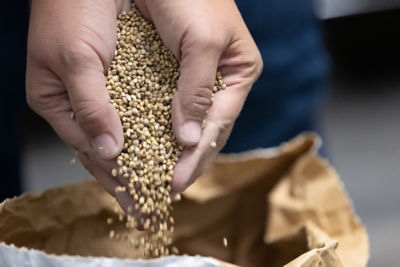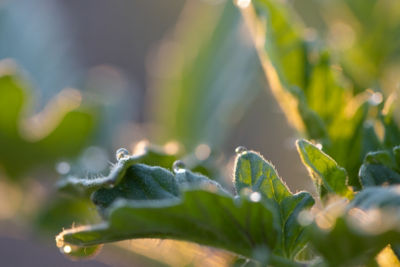Click here to download a PDF version of this spotlight.
» Plastic mulches can result in earlier harvest, enhanced yields, and increased product quality of several vegetable crops.
» Mulching can contribute to insect, disease, and weed management efforts
» Research is being conducted to help solve issues of disposal and environmental persistence associated with mulches.
Polyethylene (PE) films started to be used as mulches in commercial vegetable production in the U. S. in the 1950s and 1960s. Plastic mulches are commonly used in the production of brassicas, cucumber, eggplant, melon, okra, pepper, tomato, and watermelon.1,2 Plastic mulches are one component of the plasticulture system of vegetable production that can also include the use of drip irrigation, fumigation, and fertigation.
Several colors of plastic mulch are available, including black, white, white-on-black, clear, green, brown, red, silver, and blue. Black mulch is used most widely (Figure 1), with clear and white (white-on-black) mulches also commonly used. Mulch color affects soil temperatures, light levels under mulch, and light quality in the crop canopy.1,4
ADVANTAGES
- Increased soil temperatures
- Increased early season plant growth leading to earlier maturation and harvest
- Higher total yields with some crops (cucumber, eggplant, melon, okra, pepper, squash, tomato, and watermelon)
- Reduced water evaporation from soil surfaces, increased irrigation efficiency
- More uniform soil moisture levels in the root zone
- Shedding excess water from beds reduces drowning
- Reduced leaching of nutrients from the root zone
- Weed control with opaque and wavelength-selective mulches
- Reduced soil compaction and increased aeration
- Reduced root pruning from cultivation
- Cleaner produce from fruit not resting on soil and reduced soil splashing
DISADVANTAGES
- Need to dispose of the used plastic mulch (burning, burial, sending to landfill)
- Contamination with soil and plant matter reduces the opportunity to recycle used plastic mulch.
- Additional costs of production (bed shapers, mulch layers, special transplanters and seeders, labor for application, maintenance, and removal of mulch) (Figure 2)

SOIL TEMPERATURE
The effects of mulching on soil temperature are determined by the ability of the mulch to reflect, absorb, and transmit solar radiation (light). Clear mulch transmits the most radiation to the underlying soil, followed by red, green, yellow, blue, and black, with black mulch blocking almost all of the radiation. Black mulches absorb most UV, visible, and infrared wavelengths but reradiate much of that energy back into the atmosphere.1,4 Black mulch does transfer energy to the underlying soil through conduction, meaning that the mulch needs to be in direct contact with the soil to be most effective for soil heating. Soil temperatures under black mulch tend to be about 5°F (2.8°C) higher at a two-inch depth than similar non-mulched soil.
Soil temperatures tend to be highest under clear plastic mulch because most of the radiation energy is transmitted to the soil directly. The formation of water droplets on the underside of the mulch helps prevent the energy from reradiating back through the mulch. Soil temperatures under clear mulch tend to be 8° to 14°F (4.4 to 7.8°C) warmer at a depth of two inches as compared to non-mulched soil. Clear mulches tend to be used primarily in northern regions where higher levels of soil heating are desirable early in the season.1,2,4

White, white-on-black, and silver (reflective) mulches reflect solar radiation back into the canopy and transmit little to the soil. These types of mulches can lower soil temperatures by several degrees compared to non-mulched soils. The lower temperatures can help seedlings of cool-season crops to become established when planted in the warm summer months.1,2
Infra-red transmitting (IRT) mulches and other wavelength-selective mulches tend to warm soils to levels between those under clear and black mulches. Visible light wavelengths, especially those used by plants for photosynthesis, are reflected or blocked from reaching the soil, which helps inhibit weed growth. Infra-red and near-infra-red light is transmitted to the soil and contributes to soil warming.5
SOIL MOISTURE
Plastic mulches help reduce water evaporation from soil surfaces, increasing water use efficiency and more even moisture distribution. Differences in soil temperature effects of different colored mulches impact the amount of water evaporating from the plant holes in the mulch layer, with higher temperatures resulting in increased evaporation. Reflection of photosynthetically active radiation (PAR) from the mulch back into the plant canopy can affect plant growth and transpiration. Cooler canopy temperatures and lower PAR levels result in lower transpiration rates, while increased canopy growth from higher PAR levels results in increased transpiration. 4
WEED SUPRESSION
Black mulch is used most widely because it blocks solar radiation from reaching the soil. The lack of light prevents most weeds from growing under the mulch. The exception is nutsedge (nutgrass), which germinates under the mulch and can penetrate the mulch layer.2,5 Clear mulches allow light to reach the soil surface, which allows weeds to grow under the mulch. Herbicides or soil fumigants are usually required to manage weeds when using clear mulches. IRT mulches allow infra-red and near-infra-red light to reach the soil surface, which allows for increased soil warming compared to black plastic mulch. However, light in the PAR region is blocked, preventing most weed growth. Because of the specific wavelengths transmitted, nutsedge growth is usually also inhibited under IRT mulches.1,5
CROP GROWTH AND PEST MANAGEMENT
Increased root growth is typically seen under mulches resulting from soil temperature and moisture factors, but mulches can also affect the development of the above-ground plant parts. White mulches, which reflect most of the blue light, can stimulate earlier branching, resulting in shorter, more highly branched plants. Other colored mulches can alter the far-red to red light (FR:R) ratio, which can affect plant height and biomass. Red mulches have been shown to increase yields in some crops, including tomato and pepper.4,6
Reflective (silver or aluminum-faced) mulches reflect light, which can interfere with the movement of aphids and help repel aphids from the crop. They are most effective early in the season before the canopy covers the mulch. These mulches can help reduce the incidence of aphid-borne viruses.1,2
ALTERNATIVE MULCHES
New types of mulches are continually being developed and evaluated to help improve performance and address the drawbacks of existing mulches. Paper mulches have been assessed for helping elevate soil temperatures to address the plastic disposal problem. Paper mulches with darkly colored surfaces were able to raise soil temperatures, increase cucumber yields, and manage weeds in one study. 7
Much work is going into developing biodegradable mulches, usually based on biological polymers such as starch, cellulose, polylactic acid, and polyhydroxyalkanoates. The advantage of these bio-polymers is that microorganisms can break them down over time. This would eliminate the need to remove the mulch from the field and find a means of disposal. One problem with some bio-polymer mulches developed so far is that they do not entirely break down in a reasonable amount of time. Mulch fragments can remain in the soil, affecting water infiltration and absorption rates. On the positive side, the breakdown products of some of these mulches can serve as carbon sources in the soil resulting in increased microbial activity and biomass.8
SOURCES
1 Lamont, W. 2017. Plastic mulches for the production of vegetable crops. In “Plastics Design Library, A Guide to the Manufacture, Performance, and Potential of Plastics in Agriculture,” Elsevier, Pages 45-60.
2 Marr, C. 1993. Plastic mulches for vegetables. Commercial Vegetable Production. Kansas State University. MF-1091.
3 Lawrence, M. 2017. In “Plastics Design Library, A Guide to the Manufacture, Performance, and Potential of Plastics in Agriculture,” Elsevier, Pages 187-195.
4 Amare, G. and Desta, B. 2021. Coloured plastic mulches: impact on soil properties and crop productivity. Chemical and Biological Technologies in Agriculture, 8:4.
5 Grubinger, V. 2004. Plastic mulch primer. University of Vermont.
https://www.uvm.edu/vtvegandberry/factsheets/plasticprimer.html.
6 Gordon, G., Foshee, W., Reed, S., Brown, J., and Vinson, E. 2010. The Effects of Colored Plastic Mulches and Row Covers on the Growth and Yield of Okra. HortTechnology 20(1):224- 233.
7 Haapala, T., Palonen, P., Tamminen, A., and Ahokas J. 2015. Effects of different paper mulches on soil temperature and yield of cucumber (Cucumis sativus L.) in the temperate zone. Agricultural and Food Science. 24:52-58.
8 Bandopadhyay, S., Martin-Closas, L., Pelacho, A., and DeBruyn, J. 2018. Biodegradable plastic mulch films: impacts on soil microbial communities and ecosystem functions. Front. Microbiol. Volume 9 – 2018. doi.org/10.3389/fmicb.2018.00819.
Websites verified 3/23/2023
ADDITIONAL INFORMATION
Performance may vary from location to location and from year to year, as local growing, soil and weather conditions may vary. Growers should evaluate data from multiple locations and years whenever possible and should consider the impacts of these conditions on the grower’s fields. The recommendations in this article are based upon information obtained from the cited sources and should be used as a quick reference for information about vegetable production. The content of this article should not be substituted for the professional opinion of a producer, grower, agronomist, pathologist and similar professional dealing with vegetable crops.
BAYER GROUP DOES NOT WARRANT THE ACCURACY OF ANY INFORMATION OR TECHNICAL ADVICE PROVIDED HEREIN AND DISCLAIMS ALL LIABILITY FOR ANY CLAIM INVOLVING SUCH INFORMATION OR ADVICE.
5010_216479 Published 04/11/2023




